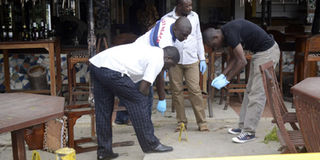Kenyans hit most by terror attacks in 2013

Bomb experts inspect an explosion scene after a grenade attack at Diani, Kwale County on January 2, 2014. Photo/KEVIN ODIT
What you need to know:
- From civilians to law enforcers and religious leaders, none has been spared the wrath of terrorists
The country suffered a series of terror-related attacks last year which left dozens dead and others injured, with security agents left struggling to contain such violence.
From civilians to law enforcers, religious leaders to merrymakers, none has been spared the wrath of terrorists who have intensified attacks in the country, especially after Kenya Defence Forces crossed into Somalia to flush out the Al-Shabaab.
Perhaps the most horrific of the attacks was on September 21 when Al-Shabaab-linked terrorists attacked Westgate Mall in Nairobi in a four-day siege in which 67 people were killed and 175 others injured.
Apart from spreading fear in the whole country and region, the massacre also left the government with egg on its face after authorities gave conflicting statements on the number of the attackers and whether any were killed by security agencies.
The government was also blamed for bungling the rescue operation which involved regular police, the elite unit Recce squad and the military.
Massive looting allegations perpetrated by the KDF at the mall during the rescue operation also dented the image of the respected military men, with the government at a loss on how to manage the fiasco.
And several months after the attack, the government has not been able to give a comprehensive and convincing details as to what transpired during the savage attack.
Although it has said only four attackers perpetrated the atrocity, security agents have not been able to provide their bodies or DNA.
However, there were moments of courage, selflessness, unity and resilience exhibited by both the terror victims, Kenyans, the security officers and various agencies following the attack.
Kenyans from all walks of life donated blood needed to save the victims and at the same time donated millions of shillings which was used to cater for the injured.
Security agencies and civilians also put their lives on the line as they attempted to rescue hostages and in the process, several officers and soldiers lost their lives.
Four suspects have already appeared in court in relation with the attack while the prestigious mall lays in ruins after part of it was blasted off by KDF during the rescue operation.
Earlier, dozen other attacks had rocked various parts of the country, with devastating effects despite promises by the government that it was on top of things.
At the beginning of last year, three Administration Police officers on evening patrol in a police vehicle were injured in a grenade attack in Garissa.
Fourteen days later, on January 14, Mr Wendo Idi Zuberi was charged with being in possession of two hand grenades and being a member of Al-Shabaab.
He was also charged with being in possession of an article connected with an offence, resisting arrest and planning to commit a felony between January 12 and 13.
He denied the charges and was remanded in police custody.
On January 22, another suspect, Rev John Kamau Mbugua, 50, was also charged with possessing bomb-making materials.
He appeared in court together with a quarry worker, Mr Samuel Chege Gitau and a student at Nembu Oasis of Freedom Pentecost Computer College, Mr John Chege Kamau.
On February 16, an explosion occurred in Garissa town sending a huge ball of fire which lit up the surrounding area.
The blast was followed by random gunshots.
The same town, which seemed to have suffered the brunt of the terror bouts also saw another attack on April 4, where a student was killed and two others seriously injured after gunmen hurled a grenade at a hotel.
A similar attack in the same town on April 18, left 10 people dead and several others seriously injured when gunmen sprayed a hotel with bullets.
On May 6, two Iranians were jailed for life for possession of 15 kilogrammes of bomb making material.
Mr Ahmad Abolfathi Mohammed, 51, and Mr Sayed Monsour Mousavi, 52, will also serve 15 and 10 years each as additional penalties for being in the country illegally and planning a major terror attack.
On May 11, a policeman and a Kenya Revenue Authority official were killed and three other officers seriously injured when gunmen fired into a police canteen in Mandera.
Eight days later, on May 19, police engaged in a dramatic shootout with a terror suspect, Mr Felix Nyangaga Otuko, and his wife in Nairobi’s Githurai Kimbo estate and managed to shoot both dead.
The couple hurled grenades that injured six police officers and unsuccessfully used their own daughter as a human shield during a 12-hour confrontation.
Mr Otuko was the main suspect in the 2011 terror attack at Mwaura’s Pub, off Tom Mboya Street, in Nairobi.
On June 9, 16 people were injured when an explosive device was hurled at an open-air crusade outside Earthquake Miracle Ministries at Mrima area in Likoni, Mombasa, while another three were injured in a grenade explosion near Nairobi’s Pumwani Maternity Hospital.
Thirteen other people were killed on June 23 in Mandera and Wajir counties, after about 50 militiamen raided an Administration Police camp.
On August 19, police detonated two bombs that had been planted at the entrance of Soldiers of Faith Church at Kiamaiko, Nairobi.




